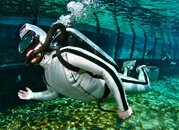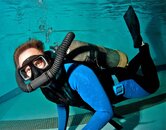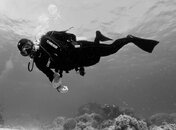I didn't see any info on how much ballast water can be taken on. Did they happen to mention that in your training?The technology is well explained on the Avelo website
You are using an out of date browser. It may not display this or other websites correctly.
You should upgrade or use an alternative browser.
You should upgrade or use an alternative browser.
Review Diving the Avelo System
- Thread starter scubadada
- Start date
Please register or login
Welcome to ScubaBoard, the world's largest scuba diving community. Registration is not required to read the forums, but we encourage you to join. Joining has its benefits and enables you to participate in the discussions.
Benefits of registering include
- Ability to post and comment on topics and discussions.
- A Free photo gallery to share your dive photos with the world.
- You can make this box go away
hammet
Contributor
Seems overly complicated to integrate it into the same cylinder.
Why not have a separate, non-compressible canister of finite volume where you can add or remove water ballast via a pump and/or low pressure inflator hose? Maybe add a piston on a spring to compress it to prevent sloshing.
Why not have a separate, non-compressible canister of finite volume where you can add or remove water ballast via a pump and/or low pressure inflator hose? Maybe add a piston on a spring to compress it to prevent sloshing.
jadairiii
Contributor
- Messages
- 1,378
- Reaction score
- 2,102
Interesting, you have all of the same "failure points" of a "standard" SCUBA rig, and the Avelo system found a way to add at least:
1. Battery and wiring
2. Battery cap
3. Electrical Switch
4. mechanical pump
5. Pump Cap
6. Pump valve and purge
7. plumbing from pump to tank inlet (with QD)
8. internal tank bladder
More problematic, should the Hydrotank fail, does not seem I can seamlessly remove the Jetpac from it and throw it on a standard tank so I can keep diving. Meaning, you cant travel far from the "host" with this system.
Now, I get it, my wing has a bladder and purge but those have no effect on the operation of my SCUBA.
Per their Technical Specs, I'm trying to figure how my BP/Wing with an Alum 80 requires 14-28 pounds of additional weight? That's some "new math"?
Bottom line, this seems to be a solution to a problem that did not exist. Better get out your Amex Black Card.....
1. Battery and wiring
2. Battery cap
3. Electrical Switch
4. mechanical pump
5. Pump Cap
6. Pump valve and purge
7. plumbing from pump to tank inlet (with QD)
8. internal tank bladder
More problematic, should the Hydrotank fail, does not seem I can seamlessly remove the Jetpac from it and throw it on a standard tank so I can keep diving. Meaning, you cant travel far from the "host" with this system.
Now, I get it, my wing has a bladder and purge but those have no effect on the operation of my SCUBA.
Per their Technical Specs, I'm trying to figure how my BP/Wing with an Alum 80 requires 14-28 pounds of additional weight? That's some "new math"?
Bottom line, this seems to be a solution to a problem that did not exist. Better get out your Amex Black Card.....
- Messages
- 21,551
- Reaction score
- 21,816
- Location
- Philadelphia and Boynton Beach
- # of dives
- 2500 - 4999
I don't know. During training, we did at most 3 full pumps, 2 past neutral buoyancy.I didn't see any info on how much ballast water can be taken on. Did they happen to mention that in your training?
You might want to ask Avelo
Avelo - Contact or diveavelo@avelolabs.com
gordonscuba
Contributor
Seems overly complicated to integrate it into the same cylinder.
Why not have a separate, non-compressible canister of finite volume where you can add or remove water ballast via a pump and/or low pressure inflator hose? Maybe add a piston on a spring to compress it to prevent sloshing.
Yup, and someone will definitely make this in their garage. You could source most of the parts from other scuba systems. If the battery pack from a canister light (or at least the waterproof housing, with a different battery) can be made to feed a pump, that solves one problem. The incompressible outer housing does not need to be a scuba tank, because it only has to reliably withstand the ambient pressure -- for recreational dives, 40m = 5 bar. It could be something which seals with an o-ring or two, but is easy to open for cleaning. To all the ppl on SB who have built their own rebreathers, I would love it if you build an incompressible buoyancy compensator in your garage, and let me know what parts you used.
This concept has been tried many times...Yup, and someone will definitely make this in their garage. You could source most of the parts from other scuba systems. If the battery pack from a canister light (or at least the waterproof housing, with a different battery) can be made to feed a pump, that solves one problem. The incompressible outer housing does not need to be a scuba tank, because it only has to reliably withstand the ambient pressure -- for recreational dives, 40m = 5 bar. It could be something which seals with an o-ring or two, but is easy to open for cleaning. To all the ppl on SB who have built their own rebreathers, I would love it if you build an incompressible buoyancy compensator in your garage, and let me know what parts you used.
US Patent for Method of and apparatus for bouyancy compensation for divers Patent (Patent # 8,152,413 issued April 10, 2012) - Justia Patents Search
An improved buoyancy compensation device having a lesser change in buoyancy with depth than conventional buoyancy compensation devices which use ambient pressure bladders is disclosed. The improved device comprises one or more elastic members that, throughout the working range of diving...
 patents.justia.com
patents.justia.com
Still Kicking
Contributor
Thanks for the review.The Avelo System is innovative diving equipment that allows you to dive differently than with traditional gear. The Avelo System consists of the Jetpack and the Hydrotank. The Jetpack is a backplate, harness, battery, and pump. The Hydrotank consists of a flexible bladder holding the gas and a rigid outer cylinder. Buoyancy is controlled by pumping water into the outer cylinder and decreasing the size of the bladder. There is no buoyancy compensator and the air bubble traditionally used to control buoyancy. The Avelo System is advertised as providing neutral buoyancy that is depth independent, less weight than traditional gear, and improved gas consumption. The technology is very well described on the Avelo website Avelo (diveavelo.com).
My wife and I recently returned from a two week trip to Bonaire, December 6-20, 2023. We took advantage of the fact that Avelo training and use is offered by Dive Friends on Bonaire. Training and use of the Avelo System is currently offered in just three locations, Bonaire, Catalina, California, and Sydney, Australia. Early in our stay, we took the one day, two dive Recreational Avelo Diver (RAD) course and on the second day did two additional guided dives. Later in our visit, we rented Avelo gear and did three independent dives in a day.
The Recreational Avelo Diver course starts with a well-designed eLearning exercise in three sections, concepts behind traditional and Avelo diving, components of the Avelo System, and procedures for use of the Avelo equipment. Open Water scuba certification is a prerequisite for RAD certification. The RAD course begins with a classroom review of the Avelo gear and its use. This is followed by the two certification dives. These were done as shore dives at Something Special, across the street from the Dive Friends Retail & Dive Shop. The first dive was mainly getting use to the Avelo System and included a weight check at the surface, using the equipment to achieve neutral buoyancy, and then swimming around at different depths. You do use a small amount of weight in the base of the Hydrotank to adjust your buoyancy at the surface, I used four pounds and my wife used three. The ease of achieving neutral buoyancy and the depth independence was startling. The second dive consisted mainly of skills, doffing and donning, simulated pump running by adding two extra pumps, simulated loss of ballast water by purging at depth, a shared gas ascent, and deploying the integrated SMB at the surface. The two simulated failures were easy to deal with. The extra weight of the excess pumps was not difficult to swim with and one could always open the purge valve. Loss of ballast water only resulted in minimal lightness and swimming was still not difficult. For either failure, one would calmly terminate the dive. After successfully completing the second dive, RAD certification was conferred. I’m extremely glad that we did the two additional guided dives on the second day. We did two more shore dives and became much more familiar with the Avelo System while enjoying the dives. Dive Friends requires four guided dives before you are allowed to rent gear for independent diving. Dive Friends was very efficient and organized in offering the RAD and additional guided dives. Our instructor and guide, Stephanie, was absolutely phenomenal. The 4 dives were done with a modified Scubapro G2 dive console that includes the Avelo Mode. It was extremely interesting to see our dive profiles along with gas consumption rates and where we fell in the optimal buoyancy range.
Towards the end of our stay on Bonaire, we rented Avelo gear for a 3 dive day. We picked up two Jetpacks, six Hydrotanks, and 4 batteries and off we went. Our initial setup was a bit slow, we improved with practice. The dives went well with excellent neutral buoyancy and depth controlled with breathing and gently swimming up and down. We appreciated the lighter weight of the equipment. My gas consumption is better than average. After only 7 dives with the Avelo System, I have not yet realized the improvement in gas consumption. Some of this may be gaining familiarity with the equipment as my gas consumption was improving over my three independent dives.
Is Avelo the diving of the future, I don’t know? Expansion of the number of training sites, wider availability of equipment, sale of equipment to individuals, and presence of the Avelo Mode on a number of popular computer platforms are some of the variables. Information recently released at the 2023 DEMA sheds some light on the future. Avelo is currently opening central dive shops in diving regions that, in addition to professional and recreational training, will serve as a hub for expansion. Several new Avelo Dive Centers will open in 2024. Avelo equipment will be available for sale in the second half of 2024 with prices announced by the Avelo Dive Centers.
Our experience with the Avelo System in Bonaire was interesting and enlightening. The RAD course and two additional guided dives cost $700 per person and the rental day cost $110 per person. I will give Avelo another try and hone my skills when I have the opportunity to return to Bonaire, maybe earlier.
At DEMA, the Avelo staff was saying the system is so effortless that would never go back to diving with a traditional BC again. That smelled a lot like Koolaid to me. Do you see how someone could feel that way?
- Messages
- 21,551
- Reaction score
- 21,816
- Location
- Philadelphia and Boynton Beach
- # of dives
- 2500 - 4999
Hi @rmorganDada, how many units do you think DF has?
Dive Friends got back to me, they currently have 10 Jetpacks and 20 Hydrotanks. More equipment is on the way. They will do the RAD course with up to 4 students.
- Messages
- 21,551
- Reaction score
- 21,816
- Location
- Philadelphia and Boynton Beach
- # of dives
- 2500 - 4999
Hi @Still KickingThanks for the review.
At DEMA, the Avelo staff was saying the system is so effortless that would never go back to diving with a traditional BC again. That smelled a lot like Koolaid to me. Do you see how someone could feel that way?
I enjoyed learning to use and then using the Avelo equipment. All but 7 of my 2343 dives since 1997 have been with traditional equipment and I believe I have become quite adept at it. For a whole variety of reasons, most of my future dives will also be with traditional equipment.
The diving with Avelo gear was nearly effortless, despite the fact that I was very early on the learning curve. If I had ready access to Avelo equipment at a competitive cost to dive, I might very well choose to dive exclusively with that gear. That is not the case, so it is a moot point for me.
I wrote this review simply to share my initial experience. I also tend to be on the skeptical side. To all who have posted without experience, I would simply say, give it try and then come back and share your own thoughts. The Avelo System is significantly different than traditional equipment, perhaps a bit much to swallow without a personal trial.
David Haas
Contributor
If I may add some comments.....
I haven't tried the Avelo system yet but hope to possibly this year on Bonaire or maybe Catalina. One thing people might be missing is the total elimination of a BCD. If I told you to swim underwater here, hold this bag and blow air in it, dump it, blow some back in while swimming around" you'd think what the heck?
I started diving in 1969 and sometimes go play in a pool with just a backpack and tank. The difference in streamlining and "feel" is like nothing duplicated even with my small light travel Aqualung ZUMA (I'm a warm water wimp but use it with a 5mm suit and 20 lbs lead sometimes.)
I confess to my "less is more" choice for any diving and don't clip off lots of accessories, etc. So going to something as streamlined as the Avelo would be so close to when I began "sport diving" as possible. I regularly see people even on tropical trips equipped like they're diving the Andrea Doria all for a 60' or shallower dive.
Is the Avelo expensive currently? YES......
Does it challenge traditional concepts of buoyancy using a "submarine" hard hull philosophy? YES........
The benefits of less weight to counteract various thermal protection with simpler less frequent buoyancy adjustments are the main features. I'm sure incremental advancements will come too so don't be so sure it won't reach adoption by many folks.
I heard the same thing going way back to "why do I need a SPG, BCD, Dive Computer" etc......
I'm sure a few other things I haven't thought of might be VERY attractive to the typical warm water enthusiast is all.....
Just one old guy's random thoughts
David Haas



I haven't tried the Avelo system yet but hope to possibly this year on Bonaire or maybe Catalina. One thing people might be missing is the total elimination of a BCD. If I told you to swim underwater here, hold this bag and blow air in it, dump it, blow some back in while swimming around" you'd think what the heck?
I started diving in 1969 and sometimes go play in a pool with just a backpack and tank. The difference in streamlining and "feel" is like nothing duplicated even with my small light travel Aqualung ZUMA (I'm a warm water wimp but use it with a 5mm suit and 20 lbs lead sometimes.)
I confess to my "less is more" choice for any diving and don't clip off lots of accessories, etc. So going to something as streamlined as the Avelo would be so close to when I began "sport diving" as possible. I regularly see people even on tropical trips equipped like they're diving the Andrea Doria all for a 60' or shallower dive.
Is the Avelo expensive currently? YES......
Does it challenge traditional concepts of buoyancy using a "submarine" hard hull philosophy? YES........
The benefits of less weight to counteract various thermal protection with simpler less frequent buoyancy adjustments are the main features. I'm sure incremental advancements will come too so don't be so sure it won't reach adoption by many folks.
I heard the same thing going way back to "why do I need a SPG, BCD, Dive Computer" etc......
I'm sure a few other things I haven't thought of might be VERY attractive to the typical warm water enthusiast is all.....
Just one old guy's random thoughts
David Haas



Similar threads
- Replies
- 20
- Views
- 6,679
- Replies
- 2
- Views
- 420



